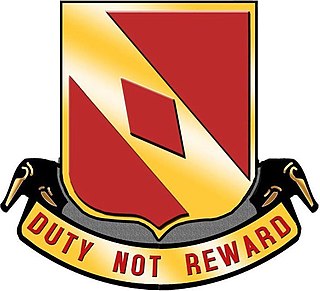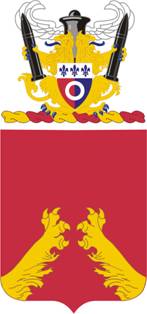
The 82nd Airborne Division is an airborne infantry division of the United States Army specializing in parachute assault operations into hostile areas with a U.S. Department of Defense mandate to be "on-call to fight any time, anywhere" at "the knife's edge of technology and readiness." Primarily based at Fort Liberty, North Carolina, the 82nd Airborne Division is part of the XVIII Airborne Corps. The 82nd Airborne Division is the U.S. Army's most strategically mobile division.
Operation Golden Pheasant was an emergency deployment of U.S. troops to Honduras in 1988, in response to Nicaraguan attacks on Contra logistics in Honduras.

The 1st Infantry Division (1ID) is a combined arms division of the United States Army, and is the oldest continuously serving division in the Regular Army. It has seen continuous service since its organization in 1917 during World War I. It was officially nicknamed "The Big Red One" after its shoulder patch and is also nicknamed "The Fighting First." The division has also received troop monikers of "The Big Dead One" and "The Bloody First" as puns on the respective officially sanctioned nicknames. It is currently based at Fort Riley, Kansas.
The 2nd Brigade Combat Team, 1st Infantry Division, also known as the Dagger Brigade, is a maneuver brigade combat team in the 1st Infantry Division of the U.S. Army stationed in Fort Riley, Kansas.

The 1st Battalion, 320th Field Artillery Regiment is the field artillery battalion assigned to the 2nd Brigade Combat Team, 101st Airborne Division. The battalion has been assigned to the 82nd Airborne Division, 11th Airborne Division and 101st Airborne Division. The battalion has participated in World War I, World War II, Operation Power Pack, Operation Urgent Fury, Operation Desert Storm, Operation Iraqi Freedom, Operation Enduring Freedom, and Operation Inherent Resolve.

The 3rd Brigade Combat Team, 1st Cavalry Division is a combined arms armored brigade of the 1st Cavalry Division based in Fort Cavazos, TX. Major equipment includes the M1A2SEP Tanks, M2A3 & M3A3 Bradley infantry fighting vehicles, M109A7 Paladin howitzers, and M1114 up-armored Humvees.

The 3rd Battalion, 29th Field Artillery is a unit of the 3rd Brigade Combat Team of the 4th Infantry Division, United States Army. The battalion is currently garrisoned at Fort Carson, Colorado.
The U.S. 41st Infantry Regiment is a regiment of the United States Army. Its 1st Battalion is currently assigned to the 2nd Stryker Brigade Combat Team, 4th Infantry Division. Its 3rd Battalion was assigned to the 1st Armored Brigade Combat Team, 1st Armored Division, which was replaced in 2018 by 4th Battalion, 70th Armor Regiment, 1st Brigade Combat Team, 1st Armored Division.

The 75th Field Artillery Brigade is an artillery brigade in the United States Army. It is currently based in Fort Sill, Oklahoma and supports the III Armored Corps. The brigade is officially tasked to train and prepares for combat; on orders deploys to any area of operations to plan, synchronize and execute combined, and joint fires and effects. Integrate attached ground and air maneuver forces and on order function as a maneuver headquarters in support of full spectrum operations.

The 206th Field Artillery Regiment is a United States artillery regiment, currently represented in the Arkansas Army National Guard by the 1st Battalion, 206th Field Artillery, Headquartered at Russellville, Arkansas. The 1–206th FA is an element of the 39th Infantry Brigade Combat Team.

The 1st Battalion, 21st Field Artillery was a field artillery battalion of the United States Army based in Fort Hood, Texas. It was a subordinate unit of the 41st Fires Brigade.

The 5th Field Artillery Regiment was constituted as part of the Regular Army in January 1907. Individual battalions have lineages which date back further. Currently, it is a parent regiment under the U.S. Army Regimental System, with a single active battalion, the 1st Battalion, 5th Field Artillery, which is assigned to the 1st Brigade Combat Team, 1st Infantry Division at Fort Riley, Kansas.
The 3rd Field Artillery Regiment is a field artillery regiment of the United States Army, first formed in 1812, although regimental units trace their lineages as far back as 1794. Based on the service of these antecedents, the regiment claims battle honors for the War of 1812, the Seminole campaign, the Mexican War, the Civil War, the Spanish–American War, and the Philippine Insurrection. The regiment served with the 6th Division during World War I, with the 5th Division, 6th Division and 2d Cavalry Division between the world wars, and with the 9th Armored Division during and after World War II. Since 1961, the regiment has been a parent regiment under the Combat Arms Regimental System and the U.S. Army Regimental System, with regimental elements serving with the 1st, 6th, and 8th Infantry Divisions; 2nd and 3rd Armored Divisions; 1st Cavalry Division; 194th Armored Brigade; and various field artillery brigades and groups. Two regimental battalions are currently active: the 2nd Battalion in the 1st Armored Division and the 5th Battalion in the 17th Field Artillery Brigade

The 6th Field Artillery Regiment is a Field Artillery Branch regiment of the United States Army first activated in 1907 from numbered companies of artillery. It was first organized with two battalions.

The 20th Field Artillery Regiment is a field artillery regiment of the United States Army constituted 1 July 1916 in the Regular Army. It served in France during the First World War with the 5th Division, at St. Mihiel and Lorraine before inactivation on 5 September 1921 at Camp Bragg, North Carolina.
The 377th Field Artillery Regiment is a field artillery regiment of the United States Army. A parent regiment under the U.S. Army Regimental System, the regiment's 2nd Battalion, 377th Field Artillery Regiment is assigned to the 2nd Infantry Brigade Combat Team (Airborne), 11th Airborne Division. Elements of the regiment have also served with the 101st Airborne Division and 82nd Airborne Division, and have seen service in World War II, Vietnam, and in both Iraq and Afghanistan during the Global War on Terror. The 1st and 3rd Battalions as well as Batteries D and E are Inactive.
The 2nd Battalion, 8th Field Artillery Regiment is the field artillery battalion organic to the 1st Infantry Brigade Combat Team, 11th Airborne Division. Originally organized in 1916, the battalion has seen combat service in World War I, World War II, Korea, and the Global War On Terror. Most recently deploying to Iraq in support of Operation Inherent Resolve. The Automatic Battalion has earned, 14 campaign streamers and at least 8 unit awards. The battalion is currently at Fort Wainwright, Alaska.

The 1st Armored Division Artillery (DIVARTY) is the divisional artillery command for the 1st Armored Division at Fort Bliss, Texas. The DIVARTY has served with the division in World War II and the first Persian Gulf War, and in peacetime at Fort Hood, Fort Bliss, Fort Polk and Germany. The DIVARTY was inactivated in 2007 as part of transformation to modular brigade combat teams, but was reactivated in 2014 to provide fire support coordination and mission command for the training and readiness of field artillery units across the division.
The 1st Cavalry Division Artillery (DIVARTY) or "Red Team" is the Force Field Artillery Headquarters for the 1st Cavalry Division. The DIVARTY served with the division from 1941 to 2005, including combat service in World War II, the Korean War, the Vietnam War, Operations Desert Shield and Desert Storm, and Operation Iraqi Freedom and in peacetime in Japan, Korea, and Fort Hood, Texas. As the Force Fires Headquarters, the DIVARTY provides fire support coordination and mission command for the training and readiness of field artillery units across the division.

The 2nd Battalion, 321st Field Artillery Regiment is an inactive field artillery battalion of the United States Army. The battalion served in World War I, World War II, Vietnam and the Global War on Terrorism with the 82nd Airborne and 101st Airborne Divisions. The battalion was inactivated in 2014 as part of force reductions.















